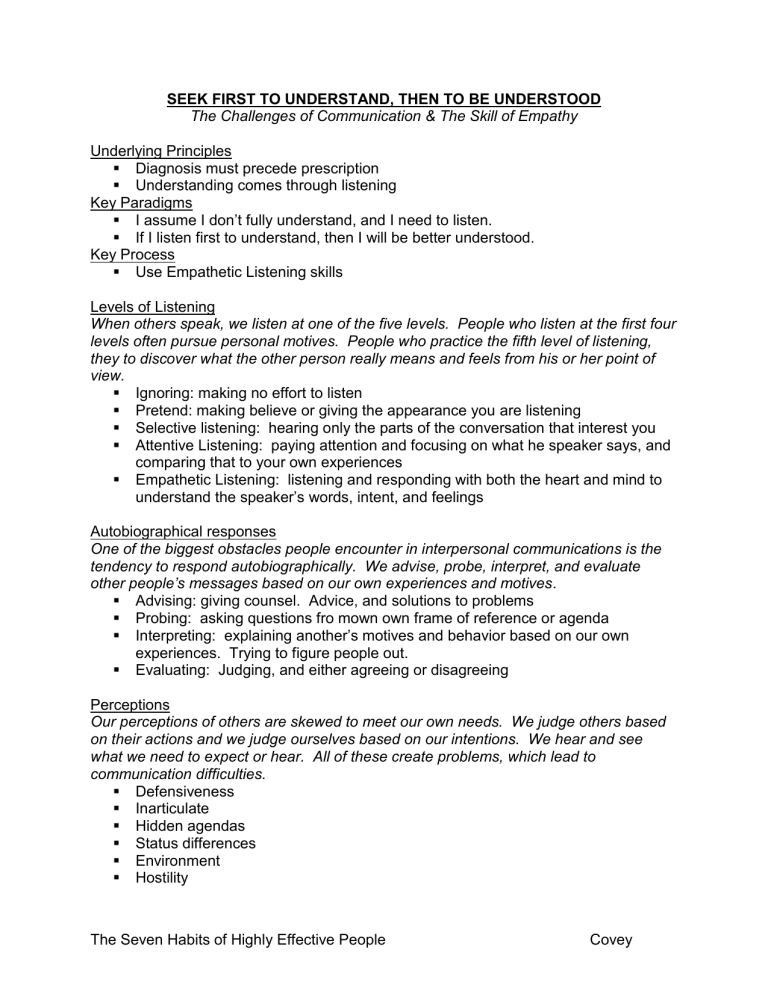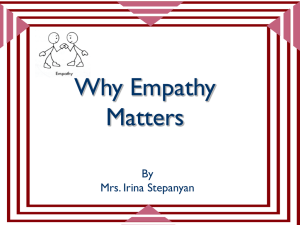seek first to understand, then to be understood

SEEK FIRST TO UNDERSTAND, THEN TO BE UNDERSTOOD
The Challenges of Communication & The Skill of Empathy
Underlying Principles
Diagnosis must precede prescription
Understanding comes through listening
Key Paradigms
I assume I don’t fully understand, and I need to listen.
If I listen first to understand, then I will be better understood.
Key Process
Use Empathetic Listening skills
Levels of Listening
When others speak, we listen at one of the five levels. People who listen at the first four levels often pursue personal motives. People who practice the fifth level of listening, they to discover what the other person really means and feels from his or her point of view.
Ignoring: making no effort to listen
Pretend: making believe or giving the appearance you are listening
Selective listening: hearing only the parts of the conversation that interest you
Attentive Listening: paying attention and focusing on what he speaker says, and comparing that to your own experiences
Empathetic Listening: listening and responding with both the heart and mind to understand the speaker’s words, intent, and feelings
Autobiographical responses
One of the biggest obstacles people encounter in interpersonal communications is the tendency to respond autobiographically. We advise, probe, interpret, and evaluate other people’s messages based on our own experiences and motives .
Advising: giving counsel. Advice, and solutions to problems
Probing: asking questions fro mown own frame of reference or agenda
Interpreting: explaining another’s motives and behavior based on our own experiences. Trying to figure people out.
Evaluating: Judging, and either agreeing or disagreeing
Perceptions
Our perceptions of others are skewed to meet our own needs. We judge others based on their actions and we judge ourselves based on our intentions. We hear and see what we need to expect or hear. All of these create problems, which lead to communication difficulties.
Defensiveness
Inarticulate
Hidden agendas
Status differences
Environment
Hostility
The Seven Habits of Highly Effective People Covey
Communication is paying attention to:
Appearance
Posture
Body Language
Gestures
Eye Contact
Facial Expressions
Voice: pitch, volume, inflection, and pace
Listening empathetically is vital under certain conditions.
Empathy is not sympathy. We have empa thy when we put ourselves in another’s place and experience feelings as he or she experiences them. This does not mean we agree
(as in sympathy), but that we understand the other point of view .
When the interaction has a strong emotional component.
When the relationship is strained or trust is low
When we are not sure we understand
When the data is complex or unfamiliar
When we are not sure the other person feel confident that we understand
Empathetic Listening Responses
The skill of empathetic listening takes practice. It combines several skills, including capturing feelings from nonverbal clues and phrasing empathetic responses clearly and supportively.
Repeat verbatim
Rephrase content
Reflect feelings
Rephrase content and reflect feelings
Discern
Empathetic listening is not good for everything.
Sometimes only silence and patience work.
In many interactions, autobiographical responses work.
Sometimes nothing works.
Empathetic listening is one of many tools to help us understand others.
Seeking to be understood
The second half of the skill of creating understanding is seeking to be understood.
When you present your won ideas clearly, specifically, visually, and most importantly contextually- in the context of their paradigms and concerns- you significantly increase the credibility of your ideas.
Like win-win, this habit balances courage and consideration.
While understanding another person takes consideration, getting another person to understand us takes courage.
The Seven Habits of Highly Effective People Covey





